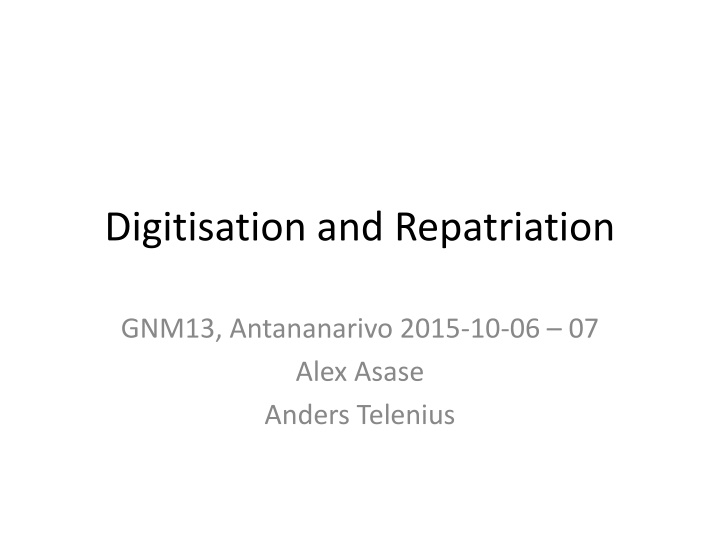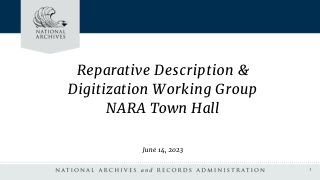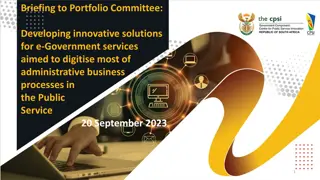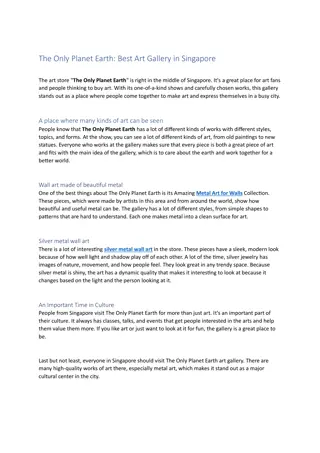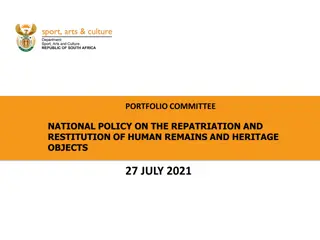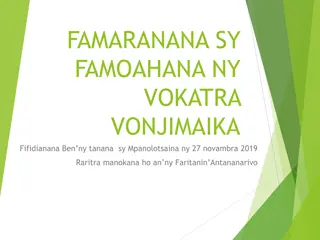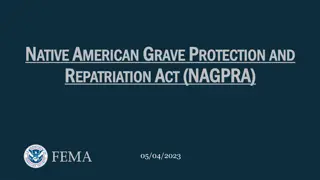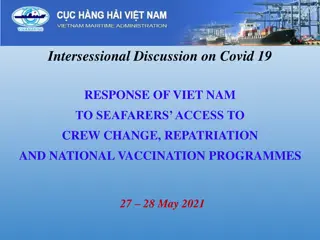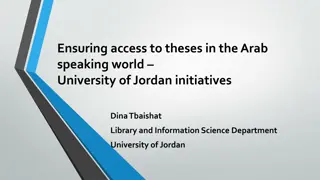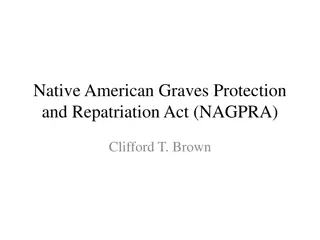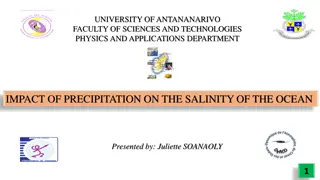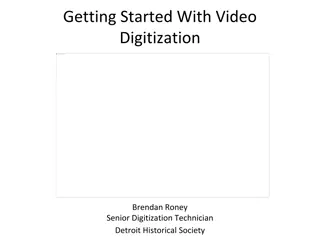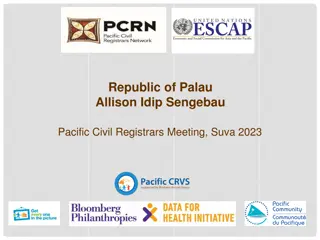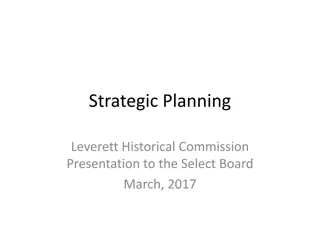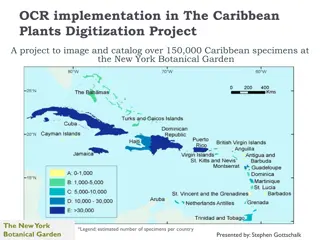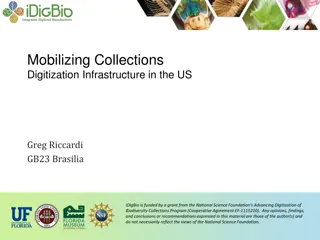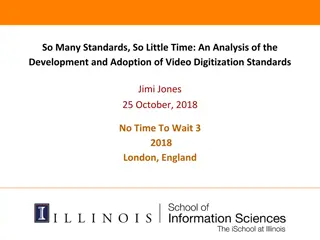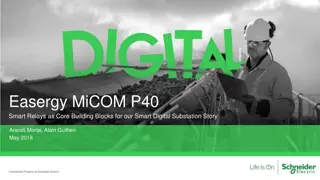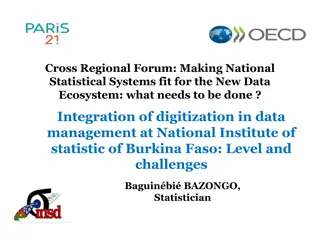State-of-the-Art Digitization and Repatriation Efforts in Antananarivo 2015
Cutting-edge digitization and repatriation initiatives in Antananarivo, 2015, led by Alex Asase and Anders Telenius, have resulted in the availability of over 580 million biodiversity occurrence records via GBIF. These efforts aim to bridge gaps in species composition knowledge, encourage time-series analysis, and support data repatriation while enhancing research prospects. The project showcases the challenges and advancements in digitizing natural history collections globally, advocating for improved data management and quality assurance practices.
Download Presentation

Please find below an Image/Link to download the presentation.
The content on the website is provided AS IS for your information and personal use only. It may not be sold, licensed, or shared on other websites without obtaining consent from the author.If you encounter any issues during the download, it is possible that the publisher has removed the file from their server.
You are allowed to download the files provided on this website for personal or commercial use, subject to the condition that they are used lawfully. All files are the property of their respective owners.
The content on the website is provided AS IS for your information and personal use only. It may not be sold, licensed, or shared on other websites without obtaining consent from the author.
E N D
Presentation Transcript
Digitisation and Repatriation GNM13, Antananarivo 2015-10-06 07 Alex Asase Anders Telenius
Digitization and Repatriation: GNM13, Antananarivo 2015-10-06 07 (Alex Asase, Anders Telenius) Digitisation state-of-the-art (1/4) By October 2015 ca. 580 M biodiversity occurrence records have been made available via GBIF, almost 460 M of which (80%) represents observational reports, 290 M dating from yr 2000 or later.
Digitization and Repatriation: GNM13, Antananarivo 2015-10-06 07 (Alex Asase, Anders Telenius) Digitisation state-of-the-art (2/4) The remaining 120 M records shown refer to less than 5% of the estimated no. of objects accumulated over centuries in natural history collections worldwide (< 3 000 M objects).
Digitization and Repatriation: GNM13, Antananarivo 2015-10-06 07 (Alex Asase, Anders Telenius) Digitisation state-of-the-art (3/4) In Europe alone only 10-20% out of >1 000 M objects from all over the globe are catalogued in digital format, altogether only ca. 25 M being accompanied also by images.
Digitization and Repatriation: GNM13, Antananarivo 2015-10-06 07 (Alex Asase, Anders Telenius) Digitisation state-of-the-art (4/4) Due to the (known) relative taxonomic, tempo- ral and geographic generality of collection con- tents as compared with the extant reporting trends (birds; W. Europe, N. America), a major digitisation effort would strongly support re- patriation of data and at the same time enable novel research focusing on time-series analysis and closing gaps in species composition knowledge!
Digitization and Repatriation: GNM13, Antananarivo 2015-10-06 07 (Alex Asase, Anders Telenius) What do we know? (1/8) A recent report (Phillips, S., Green, L. and Weech, H. 2014. Review of Current Digitisation Workflows and Equipment; http://www.synthesys.info/wp- content/uploads/2014/01/NA3-Del.-3.3-Review-of- Digitisation-workflows-and-equipment.pdf) addressing 18 European Synthesys ( Synthesis of Systematic Resources ) partners on existing and planned digitisation activities (workflow, equipment, data management, quality assurance procedures) states that:
Digitization and Repatriation: GNM13, Antananarivo 2015-10-06 07 (Alex Asase, Anders Telenius) What do we know? (2/8) all responding major European institutions host several different collections consisting of ca. 15 000-80 M items each (average 6 M/ collection) that have to varying levels underwent digitisation.
Digitization and Repatriation: GNM13, Antananarivo 2015-10-06 07 (Alex Asase, Anders Telenius) What do we know? (3/8) Preserved specimens represent 2 - 3- dimensional, dry or liquid preserved macro- and microscopic objects: plants (mostly dried), fungi including lichens (dried, freeze-dried), animals (whole animals, skin, skeletal parts, tissue samples, eggs), fossils (plants and animals; microfossils), minerals and written records (note books, checklists etc.) dating from the 16th century -present.
Digitization and Repatriation: GNM13, Antananarivo 2015-10-06 07 (Alex Asase, Anders Telenius) What do we know? (4/8) Present digitisation priorities: 1. Type specimens; 2. Specific subsets; 3. Research needs; 4. Loans; 5. New accessions; 6. Methods development; 7. Exhibitions; 8. Preservation needs.
Digitization and Repatriation: GNM13, Antananarivo 2015-10-06 07 (Alex Asase, Anders Telenius) What do we know? (5/8) Workflow (generic): 1. Selection; 2. Transfer to digitisation station; 3. Barcoding; 4. Full or partial data capture including imaging; 5. Records management; 6. Transfer to storage; 7. Quality assurance.
Digitization and Repatriation: GNM13, Antananarivo 2015-10-06 07 (Alex Asase, Anders Telenius) What do we know? (6/8) Workflow (specific): 1. Order and completeness of generic workflow components varies; 2. Equipment (cameras, scanners, X-ray, OCR, software); 3. Projects (Outsourcing, Volunteers)
Digitization and Repatriation: GNM13, Antananarivo 2015-10-06 07 (Alex Asase, Anders Telenius) What do we know? (7/8) Time/Price # Obj./yr Time/obj. Price/ (EUR) obj. 1 500-75 000 10 -60 0.6-20 Botany 1 000-10 000 15 -180 2-28 Zoology Entomology (ind.) 3 000-10 000 10 -60 1.63-5 Entomology (drawer) 2 000-5 000 5 -45 15 3 000-10 000 5 -60 0.5-21 Paleontology 350-4000 10 -30 0.4-50 Geology Anthropology/ Archaeology 700-1 500 30 -180 ?
Digitization and Repatriation: GNM13, Antananarivo 2015-10-06 07 (Alex Asase, Anders Telenius) What do we know? (8/8) Image prop. Image res. (PPI) File format Finished..? 300-600 TIFF/JPEG 2115? ?Botany ?-300 (-600) TIFF/JPEG 2115? Zoology Entomology (ind.) -300 TIFF/JPEG 2215? Entomology (drawer) -300 TIFF/JPEG 2030? 180-600 TIFF/JPEG 2165? Paleontology -3000 TIFF/JPEG 2115? Geology Anthropology/ Archaeology -2000 TIFF/JPEG 2115?
Digitization and Repatriation: GNM13, Antananarivo 2015-10-06 07 (Alex Asase, Anders Telenius) The proposed future digitisation process 3 7 5 1 4 6 8 10 11 6 5 6 2 9 7 9 3 9
e-BioColl.se (Kongsvoll 2-4 Sep. 2014) Workflow processes 2 1 3 2a 1a 2b 2c 1b 2d 1c
Digitization and Repatriation: GNM13, Antananarivo 2015-10-06 07 (Alex Asase, Anders Telenius) Transcription, Validation 1 5 4 2 3
Digitization and Repatriation: GNM13, Antananarivo 2015-10-06 07 (Alex Asase, Anders Telenius) Data Management
Digitization and Repatriation: GNM13, Antananarivo 2015-10-06 07 (Alex Asase, Anders Telenius) What next? (1/?) France: National collections digitization programme Netherlands: National digitization programme Finland: Digitarium Others?
Digitization and Repatriation: GNM13, Antananarivo 2015-10-06 07 (Alex Asase, Anders Telenius) What next? (2/?) DEDDI (EU), SeIBER incl. eBioColl.se (Sweden), RBG Edinburgh, RGB Kew, CETAF strategic plan (CETAF38 GM invitation_13-14 October 2015 ), TDWG, GBIF Collaborate!
TG Group Yellow Digitization/Repatriation Summary Please explain your interest in this group (what are your expectations, are you directly involve in digitization projects?) - All B-O-group members in some way and to different degree involved in digitization activities (projects or not) and acknowledge this activity as being fundamental for access to historically geographically and taxonomically distributed data and their repatriation. Expectations differ widely; if and when funded, collection digitization is carried out but no one expects completely digitized collections (however some more or less fully digitized [sub-]collections exist [mostly herbaria] but definitions vary).
TG Group Yellow Digitization/Repatriation Summary If possible give an estimate to the degree of digitization of known natural history collections within your country/region (object types; institutions; ambition timeline/price per object; data storage capacity needed). Knowledge in the group (on-site survey): - Global Plant Initiative (GPI) and African Plant Initiative (API) mentioned as strongly supportive of collection management and digitization. Likewise GBIF Biodiversity Information for Development (BID) contains elements of c.m and dig. - Argentina: national database system in use; publishing through GBIF.
TG Group Yellow Digitization/Repatriation Summary - Australia: Previously Atlas of Living Australia (ALA) funds supported extensive digitization of 20-30% of 41 M objects, and substantial pats of collections are published. - China: ABCDn meeting on digitization (among others) planned in November 2016 in China. - France: Digitization funded through eReColNat (4 yrs). Includes the Paris herbarium (8-19 M objects basically completed including Citizen Science support Les Herbonautes ), but next other collections are being treated. SEP-SEPDEC support (primarily?) to African colleagues in Guinea, Madagascar W. African countries.
TG Group Yellow Digitization/Repatriation Summary - Portugal: Runs CPLP programme digitization of 2,5 M objects including Porbiota (= Les Herbonautes translated), and participated in API, thus Angola (ca. 20 coll.; 150 000 objects) and Mozambique (ca. 20 coll.; 120 000 objects) have received support in managing collections however no currently running digitization projects). - Sweden: 33 M objects (+ 80 M insects in sample based data- set). 20-30% of botanical collections (8 M objects) digitized, 2-5 % of entomological collections and up to 100% of vertebrates. Traditional scanning + still photo and data treatment. National web-based open source collection management system (DINA) introduced to manage data.
TG Group Yellow Digitization/Repatriation Summary - United States: NSF (National Science Foundation) funds iDigBio (Integrated Digitized Collections) which support digitizing within the TCN (Thematic Collections Network). The JRS Foundation supports many biodiversity projects worldwide including training to expand digitization under the auspices of the Biological Heritage Library (BHL) Biological literature, recently including field notes. The Mellon foundation has long since supported digitization of type specimens from collection in many countries. Altogether >1,5 B objects in the US? As an example the Smithsonian Inst. accommodates 140 M objects; Collection Data Systems (CDS) in use to manage data. Citizen Science component: Notes from Nature ; iNaturalist .
TG Group Yellow Digitization/Repatriation Summary - W. Africa: In Ghana two JRS funded digitization projects manage 200 herbarium specimens a day (presently ca. 90% of the herbarium specimens with records in BRAHMS through national service). Repatriation project in collaboration with Togo, Benin, Nigeria and Cameroon. Following an MOU with Naturalis images from the Netherlands and France sent to W. Africa, where students carry out data capture and data cleaning/georeferencing, keeping and using data but retaining objects in Europe. Collections are encouraged to publish data. In addition African students are sent to New York Botanical Garden to carry out digitization using equipment in place (not HerbScan [?]). Georeferencing frequently favourable adopting African residents with local knowledge. Collaboration sometimes difficult on account of visa issues.
TG Group Yellow Digitization/Repatriation Report The key objectives of this break-out group are to establish an up-to-date perception of the state of natural history collection digitization known to group members, to bring out examples and discuss ambition, plans and methods for improving efficiency and speed of digitizing collections (specimens/other data sources), and to lowering the cost per fully digitized object, to enable a more efficient prioritization of data of potential significance for repatriation.
TG Group Yellow Digitization/Repatriation Report Please explain your interest in this group (what are your expectations, are you directly involve in digitization projects?) If possible give an estimate to the degree of digitization of known natural history collections within your country/region (object types; institutions; ambition timeline/price per object; data storage capacity needed).
TG Group Yellow Digitization/Repatriation Report Recommendations to the Nodes Committee, GBIF, TDWG & others: Improve promotion of collections Summary collection overview Prioritization strategy: Global, Institutional, On demand Facilities: Central, Local OCR tech./software Collection Management Systems interoperable and lasting ! Data storage needs (>>TB) Crowd Sourcing (platforms) ! !
